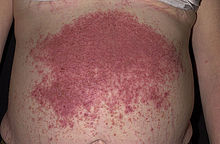Dermatitis herpetiformis Duhring
| Classification according to ICD-10 | |
|---|---|
| L13.0 | Dermatitis herpetiformis [Duhring] |
| ICD-10 online (WHO version 2019) | |
The dermatitis herpetiformis (morbus Duhring also, Duhring Brocq's disease) is a named by the dermatologist Louis Adolphe Duhring (1845-1913), skin disease is selected from the group of autoimmune blistering subepidermal blistering. Men are around 1.5 times more likely to be affected than women. The disease occurs v. a. in middle age.
Symptoms
The disease presents a diverse picture with blisters grouped like herpes . Other changes may be redness, eczema , hives, and severe, burning itching . Areas such as elbows and knees are particularly affected, but also the scalp, forehead, shoulders, buttocks and upper chest area.
Pathogenesis
The cause is a deposition of Ig -A on the basement membrane , which leads to the activation of complement factors and the associated formation of fissures and blisters. Micro abscesses form . M. Duhring is closely related to gluten- sensitive enteropathy ( celiac disease ): almost every disease coincides with (mostly asymptomatic) celiac disease. However, the reverse is not true: only a few patients with celiac disease also develop Duhring's disease. While autoantibodies against tissue transglutaminase type 2 (TGc, TGM2) expressed in the intestine play a central role in celiac disease, epidermal transglutaminase (TGe, TGM3) has been characterized as the key autoantigen for dermatitis herpetiformis. 80% of the disease is genetically associated with HLA-DR3, HLA-DQ2, HLA-DW3, HLA-A1 and HLA-B8.
therapy
The focus is on a gluten-free diet, which often brings about sufficient improvement. In addition, drug treatment with sulfone active ingredients (e.g. with Dapsone ) and antihistamines are possible .
Self-help of those affected
Due to its relative rarity, patient self-help for those affected by Duhring is taken over by the German Celiac Society (DZG eV).
See also
- Celiac disease , a disease of the gastrointestinal tract
- Gluten ataxia , a neurodegenerative autoimmune disease characterized by movement disorders
- Non-Celiac Disease-Non-Wheat Allergy-Wheat Sensitivity , still largely a diagnosis of exclusion
Web links
- "Dermatitis herpetiformis Duhring" - DermIS: A cooperation between the University of Heidelberg and the University of Erlangen-Nuremberg.
- dzg-online.de - German Celiac Society DZG eV
Individual evidence
- ↑ Barbara I. Tshisuaka: Duhring, Louis Adolphe. In: Werner E. Gerabek , Bernhard D. Haage, Gundolf Keil , Wolfgang Wegner (eds.): Enzyklopädie Medizingeschichte. De Gruyter, Berlin / New York 2005, ISBN 3-11-015714-4 , p. 326.
- ↑ Peter Fritsch: Dermatology, Venereology. 2nd Edition. Springer, Berlin / Heidelberg / New York et al. 2004, ISBN 3-540-00332-0 , pp. 259f.
- ↑ Sardy et al: Journal of Experimental Medicine . 2002, 195, 6, pp. 747-757.
- ↑ Terhorst: Dermatology. 2nd Edition. Elsevier, Munich 2009, ISBN 978-3-437-42137-2 , pp. 70f.
